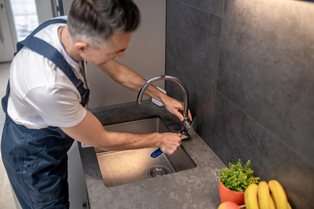DIY home improvements have captured the imagination of homeowners looking to infuse their personal touch into their living spaces. While the allure of transforming a home on your own is strong, it’s essential to balance enthusiasm with a clear understanding of the costs and complexities involved. In markets like Portland, for example, the average kitchen remodel costs homeowners $84,846, a figure that underscores the significant investment renovations can entail.
This guide aims to navigate homeowners through the DIY improvement process, helping them identify when to roll up their sleeves and when to call in the experts.
1. Understanding When to Call the Professionals:
Diving into DIY home improvement projects can be exciting, offering a sense of achievement and personalization of your space. However, it’s crucial to recognize the boundary between what you can do yourself and what requires professional intervention. For instance, while painting a room or installing new fixtures might be within your wheelhouse, more complex tasks, such as siding installation, often necessitate the expertise of professionals.
In particular, Portland siding installation experts exemplify the kind of professional assistance you might need for specific projects. Siding not only protects your home from the elements but also significantly contributes to its aesthetic and market value. Attempting to install siding without the requisite experience, tools, and knowledge can lead to issues that might compromise your home’s integrity and incur greater costs down the line. It’s instances like these where understanding the value of professional input can save you time, money, and peace of mind. Looking up the keyword Portland Siding installation company near me on any search engine will prove helpful in hiring the right experts.
2. Planning Your Project:
Every successful DIY home improvement project starts with meticulous planning. This initial stage involves setting realistic goals, budgeting carefully, and researching the scope of your project. It’s not just about the final result but also about understanding the steps, materials, and time investment required to get there. Effective planning helps you anticipate potential obstacles and devise strategies to overcome them, ensuring your project runs as smoothly as possible.
Additionally, planning involves prioritizing tasks, determining which projects will provide the most value, and aligning them with your budget and timeline. It’s about being strategic in your approach, ensuring each step is thoughtfully considered and aligns with your overall vision for the space. By dedicating ample time to plan, you’re laying a solid foundation for a successful and fulfilling DIY endeavor.
3. Acquiring the Right Tools and Materials:
Having the right tools and materials is pivotal for the success of any DIY project. It’s not just about having a hammer and nails; each task might require specific tools to achieve the desired outcome. Investing in quality materials is equally important, as they contribute to the longevity and appearance of your improvements. Understanding which materials suit your project and how to select the best tools can make a significant difference in the execution and outcome of your work.
For those who might not have an extensive collection of tools, consider renting or borrowing what you need, especially for one-off or specialized tasks. This approach is cost-effective and practical, allowing you to access the right tools without a significant upfront investment. Remember, using the appropriate tools and materials not only makes the work easier but also ensures a higher-quality finish, elevating the overall success of your DIY projects.
4. Enhancing Your Skills Through Learning:
Embarking on DIY home improvements is an excellent opportunity for personal growth and skill development. Engaging in online tutorials, attending workshops, or even enrolling in community classes can dramatically enhance your abilities and confidence in tackling various projects. These resources can provide you with step-by-step guidance, practical tips, and the foundational knowledge needed to approach your DIY tasks with greater assurance and expertise.
As you gradually take on small projects, your skill set will expand, enabling you to tackle more complex improvements over time. This incremental approach not only minimizes the risk of overwhelming challenges but also fosters a sense of achievement with each completed task. Remember, every project is a learning experience, offering valuable insights and skills that will serve you well in future endeavors. Embrace the learning process, and don’t hesitate to seek guidance when venturing into uncharted DIY territory.
5. Safety First:
The excitement of DIY projects should never overshadow the importance of safety. Ensuring you’re equipped with the right protective gear, such as gloves, goggles, or masks, is essential, depending on the nature of the task. Maintaining a well-organized workspace can prevent accidents while being mindful of your physical limits can help avoid injuries. Understanding how to correctly use your tools and materials is also crucial, as it reduces the risk of mishaps and ensures your DIY activities are both enjoyable and safe.
In addition to personal safety, consider the well-being of your home. Certain projects might involve risks to your property, such as structural alterations or electrical work, where a lack of expertise can lead to serious issues. In these cases, prioritizing safety means recognizing when a project is beyond your skill level and when it’s time to consult or hire professionals. A safe approach to DIY not only protects you and your home but also ensures that your improvements are durable and reliable.
6. Documenting and Celebrating Progress:
Keeping a record of your DIY undertakings can be incredibly rewarding. Documenting your progress with photos, notes, or even a blog can offer a sense of accomplishment and a tangible way to track your improvements over time. This documentation can also serve as a reference for future projects, helping you remember techniques, materials, and strategies that were particularly effective or challenging.
When you reach milestones or complete projects, take the time to celebrate your achievements. Sharing your progress with friends, family, or fellow DIY enthusiasts can provide motivation and perhaps inspire others to consider such home improvements. Celebrating these successes not only acknowledges your hard work and creativity but also reinforces the joy and satisfaction that come from enhancing your living space with your own hands and ingenuity.
Conclusion
DIY home improvements can be a fulfilling and practical way to enhance your living space, offering opportunities for personal growth, skill development, and even financial savings. By understanding when to seek professional help, planning your projects thoroughly, acquiring the right tools, enhancing your skills, prioritizing safety, and documenting your progress, you can navigate the world of DIY with confidence and success. Undertake each project as an opportunity to learn, innovate, and create, transforming your home piece by piece into a space that truly reflects your personality and meets your needs.





